Automatic Eclipse Photography
This article describes a camera system which I used to
automatically photograph the Total Solar Eclipses of 1999 August
11 (from the small French village of St. Marie, some 50kms
north-east of Rheims) and 2001 June 21 (from the upper Zambezi
river in Zambia). I hope it may be of use to others who are
developing their own system. Prior to the eclipse, I tested the
system on both the Moon and Sun, with the camera attached to a
Celestron C90.
There are three elements to the system:
- a Psion 3a Palmtop computer
- a Maplin RS232/IO converter
- and a Canon T70 35mm SLR camera
Psion 3a Palmtop Computer
The Psion 3a runs a small program, written in OPL,
which reads a series of commands from a 'data' file and
translates them into instructions which are sent down a
standard Psion RS232 serial lead to the RS232/IO
converter. Example commands in the data file include 'set
shutter speed' and 'fire shutter'. Commands may be either
executed immediately, or at a set time.
To arrive at precise times of 2nd and 3rd contact, I
have written a program for the Psion to calculate 'local
circumstances', based on the algorithms in Jean Meeus'
book 'Elements of Solar Eclipses 1951 - 2200'. Limb
profile corrections can be estimated graphically from the
diagram in the NASA
Solar Eclipse bulletins. The Psion program for the
series 3a/3c/mx is available as 'shareware' here. There is a Psion 5 version
available, which consists of just the minimal changes
required to get it to run on that machine, downloadable here.
|
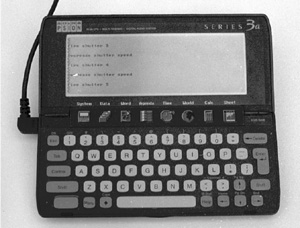 |
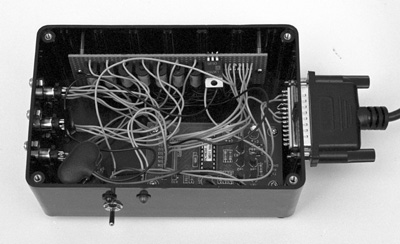 |
Maplin RS232/8-bit I/O Converter
The Maplin converter translates RS232 into 8-bit IO,
which may be configured as a mixture of inputs and
outputs. In this application all bits are set as outputs.
As the outputs are only capable of sinking 10mA, 7 of the
bits are connected to a ULN2003 relay driver, whose
outputs are connected to small reed relays. The relays
are capable of switching higher currents should I need to
do so. The converter receives instructions from the
serial port of the Psion at 1200 baud. The converter can
only signal back to the Psion that it has understood or
not understood the command. I do not have any feedback
from the camera to the Psion, so the program needs to
keep track of the current shutter speed, etc. The
converter is battery powered.
|
Canon T70 SLR camera
The Canon T70 camera is available at a reasonable price
(around £80 secondhand in the UK, body only) and has the
advantages of a built-in motor-winder, electronic shutter release
and push-button shutter speed buttons. Unlike Schneider and Evans
(see references), I did not mind dismantling my camera in order
to modify it! With the top camera housing removed, the shutter
speed buttons are revealed. I sacrificed the flash hot-shoe
connector and moved two wires from hot-shoe contacts to the
shutter speed buttons. By momentarily connecting the appropriate
flash contacts, the shutter speed changes up and down. I obtained
a secondhand flashgun, removed the base and connected three wires
back to two of the RS232/IO converter relays, (one wire is a
common return). The Canon Remote Switch 60T3 is expensive for a
cable release, but the connector on the Canon doesn't seem to be
'standard'. I added a socket to the switch and a further cable
connects to a third relay on the converter box. Using three
'bits' I can now control shutter speed up/down and shutter
'fire'. I have a further four bits available which may be used to
control a second SLR camera and a video camera.
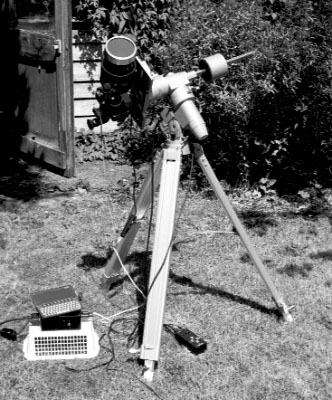 |
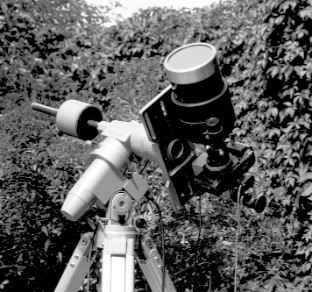 |
The 1999 August 11 Total Solar Eclipse
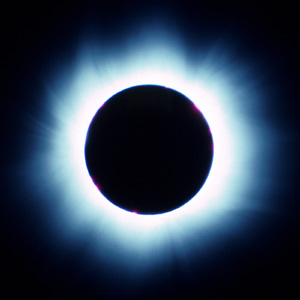
For the eclipse I used one T70, modified as above, attached to
a Celeston C90 1000mm f/11 telescope - camera 1. A second T70,
unmodified, was attached to a Sirius 500mm f/8.8 catadioptric
lens - camera 2. Camera 1 was loaded with Kodachrome 64
transparency film: my usual 'eclipse' film. Camera 2 was loaded
with Kodak Royal Gold 100 print film. Prior to 1st contact, the
internal clock on the Psion 3a was set to UTC from a Garmin GPS
12XL via the serial interface. French maps are good enough to
accurately measure longitude and latitude, the GPS unit
reassuringly confirmed this.
Camera 1 was fired for three sequences during totality: the
first run was from just before 2nd contact to capture Baily's
Beads, to 15 seconds after, for recording the chromosphere and
prominences. Exposure times ranged from 1/1000 - 1/60 second.
During the middle part of the eclipse a sequence of exposures
lasting from 1/250 - 4 seconds was taken to capture the inner and
middle corona. The third run was around 3rd contact to once again
capture prominences, the chromosphere and Baily's Beads.
Camera 2 was fired for two periods: between camera 1's first
and second run, and between the second and third run. Exposure
times ranged from 1/8 - 8 seconds. The shutter speed was
controlled simply by setting the camera on 'B', with the Psion
'holding' the shutter open for the required length of time.
By alternating the periods of camera firing I avoided any
problems due to shutter vibration from one camera affecting the
other. There was some insurance against passing cloud in that for
most of totality one or other camera was taking pictures. In fact
totality turned out to be cloudless!. Both cameras worked
faultlessly, and camera 1 appeared to change its shutter speed as
expected. Please have a look at my photographs from the 1999 Eclipse.
I will probably go on to modify my second T70 in the same way
as the first was modified, giving me a full control of shutter
speeds on both cameras.
The 2001 July 21 'African' Total Solar Eclipse
Once again, the system worked flawlessly, this time after
being bumped hundereds of kilometres over Zambian roads.
Essentially I repeated what I did in 1999. The only differences
were that I had obtained a Tamron SP 500mm f/8 catadioptric lens
for use on the second camera, and I was totally dependent on the
GPS unit to measure my position. Once again, the system worked
flawlessly, my photographs capturing 2nd contact, mid-eclipse and
3rd contact, testament to the work of Jean Meeus and Fred Espenak
in enabling such accurate predictions to be generated so easily.
My report of the eclipse together with photographs is here.
The 2005 April 8 Annular Solar Eclipse
For this eclipse, observed from Panama, I ported the software
to a Psion 5mx and took advantage of the some of the extra
features available in OPL32. The software to calculate the local
circumstances, now reads the position of the observation site
from a Garmin 16
GPS unit. As the Psion has only one serial port, I have to unplug
the GPS prior to using the camera converter. This time I used a
Pentax MZ7 camera body, but as I have not yet modified it to
allow external control of the shutter speeds, the exposure was
the same for all shots taken during this brief eclipse. There is
less 'mirror-slap' in the MZ7 compared to the T70, and the motor
speed is up to 2 fps. Here
is my report of this eclipse.
References
Maplin Electronics:
electronic components by mail-order.
- RS232-Digital Converter kit, stock code LT62S
- Reed Relay 5 Volt SPST, stock code JH12N
Glenn Schneider has an extensive article about his system
based on a Macintosh, at http://nicmosis.as.arizona.edu:8000/ECLIPSE_WEB/UMBRAPHILE/UMBRAPHILE.html.
Nigel Evans uses Schneider's solenoid system, but controlled
from a Psion 3c Palmtop. His article 'The
Automation of Solar Eclipse Photography' appears in the Journal of the British
Astronomical Association, 1999
April, vol.109 number 2.
Dr Wolfgang Strickling has built a system that takes
photographs and makes weather observations using a Psion II
Organiser. Details of his system (in German) can be found at http://home.t-online.de/home/Dr.Strickling/sofi_org.htm.
Canon T70 cameras are very popular amongst Meteor
photographers, "The Canon T70-50mm project" by Robert
Haas at http://www.delpsurf.cistron.nl/haas_array.html,
shows how to control many cameras from one 'master' fitted with
the command back.
My thanks to Nigel and Glenn for inspiration. Please get in
touch if you have any questions or suggestions.

Footnote
I used this system to photograph the Leonid Metor shower in
1999 November. The hardware was exactly as described, but I wrote
a new version of the software. The 'Meteor' software
automatically takes a specific number of (typically) 5 minute
exposures, consecutively. The high activity of the Leonids
enabled me to catch several meteor trails, including this one which shows both a Leonid
and a Taurid passing through Lepus.
2005 May 22




